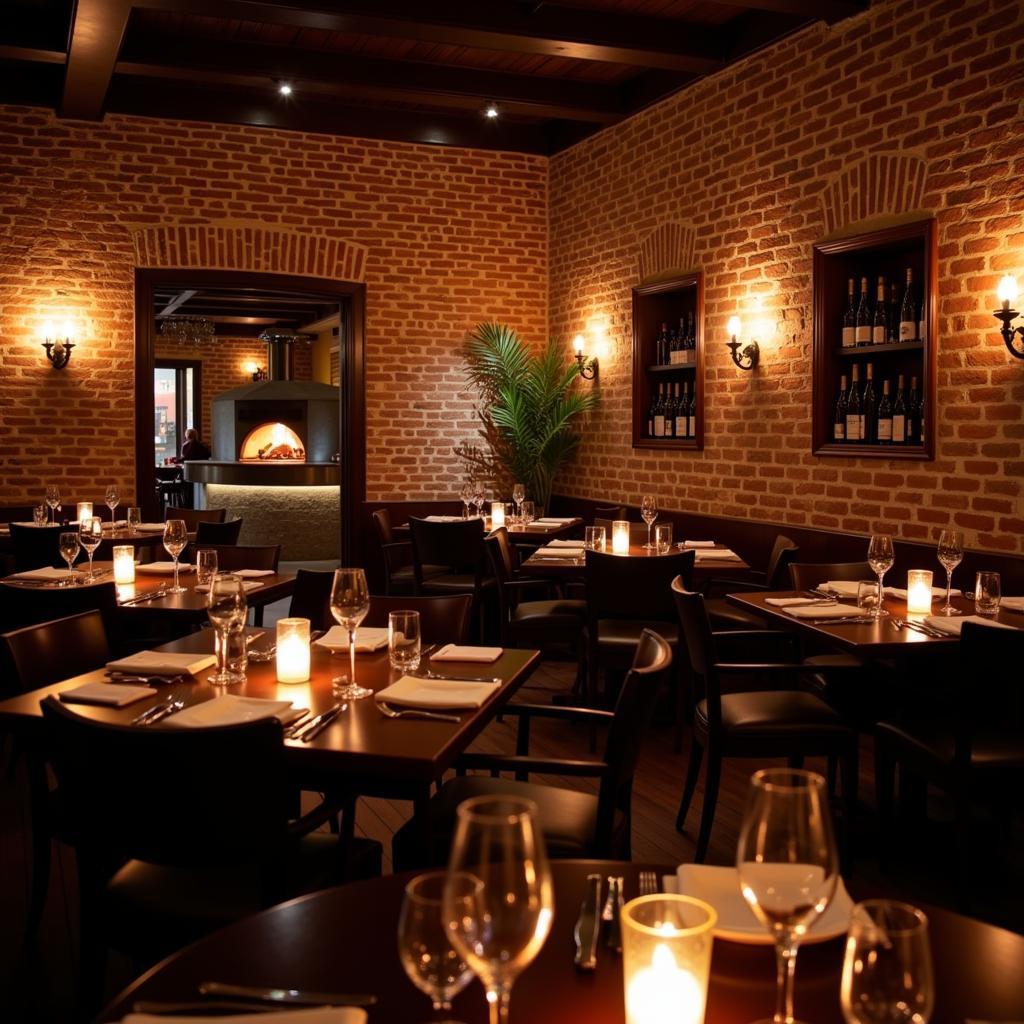Describing a recent meal at a restaurant is a common topic in IELTS Speaking tests. This theme allows examiners to assess your ability to discuss personal experiences, express opinions, and use descriptive language. Let’s explore how to excel in this topic across all parts of the IELTS Speaking test.
Part 1: Introduction and Interview
In this section, the examiner may ask general questions about your dining habits and preferences. Here are some potential questions:
- How often do you eat out at restaurants?
- What type of cuisine do you enjoy the most?
- Do you prefer eating alone or with others when dining out?
Let’s focus on answering the first question:
Examiner: How often do you eat out at restaurants?
Sample Answer (Band 6-7):
“I’d say I eat out at restaurants about once or twice a month. It’s not something I do very often, but I enjoy it when I get the chance. Usually, it’s for special occasions or when I want to catch up with friends.”
Sample Answer (Band 8-9):
“Well, I’d say my dining habits are quite varied. On average, I indulge in eating out at restaurants perhaps two to three times a month. However, this frequency can fluctuate depending on my schedule and social commitments. Sometimes, I might go through phases where I’m dining out more frequently, especially if I’m entertaining clients or celebrating milestones with friends and family.”
 IELTS Speaking: Describing a restaurant meal
IELTS Speaking: Describing a restaurant meal
Part 2: Long Turn
Here’s a sample cue card for this topic:
Describe a meal you had in a restaurant recently
You should say:
- Where the restaurant was
- What you ate
- Who you were with
- And explain why you enjoyed this meal
Sample Answer (Band 6-7):
“I recently had a meal at a small Italian restaurant in the city center. It’s a cozy place with nice decorations and a friendly atmosphere. I went there with my best friend to celebrate her birthday. We ordered pasta dishes – I had spaghetti carbonara, and she had penne arrabbiata. For dessert, we shared a tiramisu. The food was delicious, and the portions were generous. I enjoyed this meal because the food was tasty, and it was great to spend time with my friend in a relaxed environment. The service was also good, which added to the pleasant experience.”
Sample Answer (Band 8-9):
“I’d like to tell you about a memorable dining experience I had recently at an upscale Italian restaurant nestled in the heart of our city’s historic district. The establishment, known for its authentic cuisine and intimate ambiance, provided the perfect setting for a long-overdue reunion with my college roommate.
Upon arrival, we were immediately captivated by the restaurant’s rustic charm, complete with exposed brick walls and soft, warm lighting. We decided to indulge in the chef’s tasting menu, which turned out to be a culinary journey through various regions of Italy.
The meal commenced with an exquisite antipasti platter, featuring a selection of cured meats, artisanal cheeses, and marinated vegetables. This was followed by a velvety pumpkin risotto that was simply divine. The main course was a succulent osso buco, slow-cooked to perfection and served with a vibrant saffron risotto. Each course was thoughtfully paired with wines that complemented the flavors beautifully.
What made this meal truly exceptional, beyond the outstanding cuisine, was the opportunity to reconnect with my dear friend. Our conversation flowed effortlessly, much like the wine, as we reminisced about our university days and caught up on our current lives. The attentive yet unobtrusive service allowed us to focus entirely on our food and conversation, creating an atmosphere of relaxed indulgence.
This dining experience was particularly enjoyable because it seamlessly blended excellent food, a charming atmosphere, and meaningful company. It served as a poignant reminder of the joy that can be found in sharing a well-crafted meal with someone you care about, making it a truly unforgettable evening.”
 Italian restaurant interior with rustic charm
Italian restaurant interior with rustic charm
Examiner’s follow-up questions:
- Do you often try new restaurants?
- How do you choose which restaurants to visit?
Sample Answer (Band 6-7):
“Yes, I do enjoy trying new restaurants from time to time. I usually choose restaurants based on recommendations from friends or online reviews. Sometimes, if I pass by a place that looks interesting, I might give it a try.”
Sample Answer (Band 8-9):
“I’m quite enthusiastic about exploring new culinary experiences, so I make a concerted effort to try new restaurants regularly. My approach to selecting restaurants is rather multifaceted. I often rely on word-of-mouth recommendations from friends whose palates I trust, as well as reputable food critics and online review platforms. However, I also enjoy serendipitous discoveries – sometimes a restaurant’s unique ambiance or an intriguing menu glimpsed through a window can be enough to pique my interest. I find that this balanced approach allows me to discover both hidden gems and acclaimed establishments, keeping my dining experiences diverse and exciting.”
Part 3: Two-way Discussion
In this section, the examiner will ask more abstract questions related to the topic of dining out and restaurants. Here are some potential questions:
Examiner: How have eating habits changed in your country in recent years?
Sample Answer (Band 6-7):
“In recent years, eating habits in my country have changed quite a bit. People are eating out more often than before, especially young people. There’s also more interest in international cuisines, and we’re seeing more variety in restaurants. Health consciousness has increased too, with more people choosing healthier options when dining out.”
Sample Answer (Band 8-9):
“The culinary landscape in my country has undergone a significant transformation in recent years. We’ve witnessed a notable shift towards more frequent dining out, particularly among the younger generation and urban professionals. This trend is largely driven by busier lifestyles, increased disposable income, and a growing appreciation for diverse culinary experiences.
Moreover, there’s been a marked increase in gastronomic curiosity, with people becoming more adventurous in their food choices. This has led to a proliferation of restaurants offering international cuisines, from authentic ethnic eateries to fusion establishments that blend culinary traditions in innovative ways.
Simultaneously, we’ve seen a rising consciousness about health and nutrition. This has manifested in several ways, such as the emergence of restaurants focusing on organic, locally-sourced ingredients, and the inclusion of more plant-based options on menus. Many establishments now cater to specific dietary requirements, reflecting a more nuanced understanding of food allergies and lifestyle choices.
Another noteworthy trend is the increasing emphasis on the overall dining experience. Restaurants are now paying more attention to ambiance, service, and presentation, recognizing that these elements contribute significantly to customer satisfaction.
Lastly, the advent of food delivery apps and services has revolutionized the way people interact with restaurants, making it easier than ever to enjoy restaurant-quality meals at home. This has blurred the lines between home cooking and dining out, creating new challenges and opportunities for the restaurant industry.
In essence, these changes reflect broader societal shifts in values, lifestyles, and technological advancements, making the evolution of eating habits a fascinating lens through which to view cultural change.”
 Food delivery apps on smartphone
Food delivery apps on smartphone
Examiner: Do you think traditional restaurants will survive in the future, given the rise of food delivery services?
Sample Answer (Band 6-7):
“I think traditional restaurants will survive, but they might need to adapt. While food delivery is convenient, many people still enjoy the experience of dining out. Restaurants offer a social atmosphere and service that you can’t get from delivery. However, they might need to improve their offerings or create unique experiences to attract customers.”
Sample Answer (Band 8-9):
“The survival and evolution of traditional restaurants in the face of burgeoning food delivery services is a complex and multifaceted issue. While it’s undeniable that delivery services have disrupted the food industry, I believe traditional restaurants will continue to thrive, albeit with some necessary adaptations.
Firstly, it’s crucial to recognize that restaurants offer more than just food; they provide an immersive experience that cannot be replicated at home. The ambiance, social interaction, and personalized service are integral components of dining out that many people still value highly. Moreover, certain cuisines and dishes are best enjoyed fresh from the kitchen, which gives restaurants a distinct advantage.
However, to remain competitive, traditional restaurants will likely need to evolve their business models. This could involve embracing technology to enhance the dining experience, such as implementing digital menus or offering interactive chef experiences. Some may choose to diversify their offerings, perhaps by creating describe a favorite restaurant where you often eat experiences through themed nights or exclusive tasting menus.
Additionally, many restaurants are likely to adopt a hybrid approach, maintaining their dine-in services while also optimizing for delivery. This could involve designing separate menus for delivery that feature dishes that travel well, or investing in packaging that maintains food quality during transit.
It’s also worth noting that the rise of ‘ghost kitchens’ – delivery-only restaurants without a physical dining space – might actually benefit traditional restaurants by reducing overhead costs for those looking to expand their delivery options.
Ultimately, while the restaurant industry will undoubtedly face challenges, I believe the fundamental human desire for social dining experiences will ensure the survival of traditional restaurants. The key to their longevity will lie in their ability to adapt, innovate, and offer unique value propositions that set them apart from the convenience-focused delivery model.”
Key Vocabulary and Phrases for High Scores
-
Culinary journey /ˈkʌlɪnəri ˈdʒɜːni/ (noun phrase): An exploration of different foods and cuisines.
Example: “The tasting menu took us on a culinary journey through the regions of Italy.” -
Gastronomic /ˌɡæstrəˈnɒmɪk/ (adjective): Relating to the art or science of good eating.
Example: “The city is known for its gastronomic delights.” -
Ambiance /ˈæmbiəns/ (noun): The character and atmosphere of a place.
Example: “The restaurant’s cozy ambiance made it perfect for a romantic dinner.” -
Indulge /ɪnˈdʌldʒ/ (verb): Allow oneself to enjoy the pleasure of something.
Example: “We decided to indulge in the chef’s special dessert.” -
Exquisite /ɪkˈskwɪzɪt/ (adjective): Extremely beautiful, delicate, or carefully made.
Example: “The presentation of each dish was exquisite.” -
Fusion /ˈfjuːʒən/ (noun): A combination of different styles or elements, especially in cooking.
Example: “The restaurant specializes in fusion cuisine, blending Asian and Mediterranean flavors.” -
Palate /ˈpælət/ (noun): A person’s ability to distinguish between and appreciate different flavors.
Example: “The wine selection caters to even the most discerning palate.” -
Locally-sourced /ˈləʊkəli sɔːst/ (adjective): Obtained from the local area.
Example: “The restaurant prides itself on using locally-sourced, organic ingredients.”
Remember to use these words and phrases naturally in your responses, and always be prepared to explain or paraphrase if asked.
Examiner’s Advice
To achieve a high score in the IELTS Speaking test when describing a meal in a restaurant:
-
Use descriptive language: Paint a vivid picture with your words. Instead of saying “The food was good,” try “The flavors were rich and perfectly balanced.”
-
Vary your vocabulary: Use synonyms and avoid repetition. For example, instead of always saying “delicious,” use words like “mouthwatering,” “appetizing,” or “scrumptious.”
-
Employ idiomatic expressions: Incorporate relevant idioms like “feast for the eyes” or “to die for” to demonstrate your command of English.
-
Structure your answer: Organize your thoughts logically, using discourse markers like “firstly,” “moreover,” and “in conclusion.”
-
Elaborate on your points: Don’t just state facts; explain why things were important or how they made you feel.
-
Practice fluency: Aim for smooth delivery without long pauses. Regular practice with a variety of topics will help.
-
Show enthusiasm: Use intonation and emphasis to convey your excitement about the meal and the overall experience.
-
Be prepared for follow-up questions: Think about related topics like food preferences, cooking, or dining culture in your country.
Remember, the key to success is not just what you say, but how you say it. Confidence and enthusiasm can go a long way in impressing the examiner and achieving a high score in your IELTS Speaking test.
By following these guidelines and practicing regularly, you’ll be well-prepared to describe a meal you had with your friends in a restaurant or any other dining experience in your IELTS Speaking test. Good luck with your preparation!


